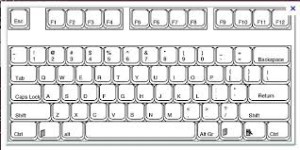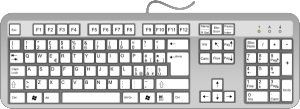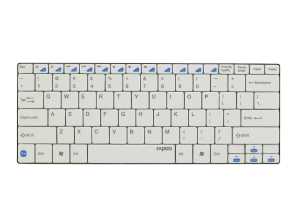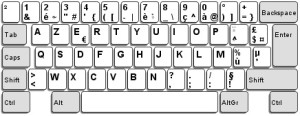IIDE Proceedings 2011 ~ Vol. 2 ~ Down-To-Earth Issues In (Mandatory) Is Use; Part I – Types Of Issue
 Abstract
Abstract
The extant discourse about mandatory IS use is not serviceable as a guide to evaluating the quality of such use as experienced by stakeholders. Many ‘down-to-earth’ issues that are crucial to such quality are overlooked. A new approach is required, which is based on what is meaningful in everyday life of use rather than on the abstractions used in academic discourse. Reasons why these abstractions are unhelpful are discussed and Dooyeweerd’s notion of modal aspects is proposed as a foundation for developing more serviceable approaches.
Keywords
Down-To-Earth, Mandatory Use, Dooyeweerd’s aspects
1. Introduction
In the era of technology, many organisations have made substantial investments in information system (IS) with the intention of increasing organisational performance. So the success or quality of IS use is often linked closely to the extent to which it contributes to organisational life, and IS use is one the important areas to be considered by management when implementing or evaluating any IS (DeLone& McLean, 1992; Venkatesh,et al., 2003).
Since the link with organisational performance is complex, broad concepts are often employed in an attempt to understand it. A common example is the extent to which an organisation deploys IT to support operational and strategic tasks (Ives &Jarvenpaa, 1991), and this is the key consequent variable in Davis’ (1989) technology acceptance model (TAM). IS use was among the most frequently used measured of success in 1992 and remained so for at least a decade (DeLone and McLean, 2003). Articles on IS use constitute around one third of the total publication space in the top IS journals, MIS Quarterly and IS Research (Barki, et al., 2007).
There are two problems. Much of this discourse is irrelevant when considering mandatory IS use (MISU) since the use is by definition 100%. So alternative concepts have been suggested, such as ‘intention to use’, which is the secondary output of TAM.Later many studies specifically focused on mandatory IS use (Ram & Jung, 1991; Lou, et al., 1995; Singletary, et al., 2002; Adamson & Shine, 2003; Ward, et al., 2005; Linders, 2006; Hennington, 2007; Lee & Park, 2008).
So why should there be yet another paper on mandatory IS use? The second problem with extant discourse, even on MISU, is that it doesn’t sufficiently express the reality of IS use on the ground.
Despite huge research in IS usage area, the use of the system is still not well understood (Mishra &Agarwal, 2009). Is it only a matter of time and incremental effort before IS use is understood? Yousafzai (2007) has collected 70 constructs related to perceived usefulness in IS use, so is it possible that IS use may be understood by rationalising them? Barki [2008] suggests four approaches to properly understanding the constructs, including defining them clearly, specifying dimensions and relationships, exploring their application to other contexts, and expanding their conceptualizaton.
Whilst such approaches might indeed help towards understanding of IS use, the present situation is reminiscent of some scientific endeavours that Kuhn (1970) observed that had reached a stage ready for paradigm shift. After a long period of incremental correction of previous views, an increasing sense of misfit between experienced reality and theories leads to a new approach to the area of reality, a new paradigm. The primary reason for this paper is to suggest a new way of looking at IS use; this focuses on what might be called down-to-earth (DTE) issues of mandatory IS use. The approach can perhaps be extended to non-mandatory IS use, so “MISU” is often rendered as “(M)ISU”.
In this paper, quality of IS use is conceived more broadly and yet also, paradoxically, in a more precise way, because of a pluralistic approach. In most literature, ‘good’ (or successful, beneficial, high quality) IS use is conceived in terms of the organisation whereas this paper also takes into account the individuals who live and work with, or are affected by, the IS. In most literature, the notion of ‘good’ is located in abstracted, predefined variables like amount of usage, intention to use or perceived usefulness (Davis, 1989), and the plethora of ‘external variables’ encountered in actual experience of IS use [Yousafzai 2007] are deemed meaningful only insofar as they contribute to the predefined variables. This paper reverses this, treating this plethora of ‘external variables’ as that which is truly meaningful, and the supposed abstract variables are defined by reference to, and as an outcome of, what occurs in everyday experience of IS use. In most literature ‘good’ IS use is seen as a goal to which everyday experience should be designed to contribute while in this paper, the ‘good’ is seen as an outcome of that everyday IS use. Most extant research in issues of IS use has been of a positivist nature; this paper takes a more interpretivist approach. Most literature focuses on issues of interest to researchers and the academic or management communities, whereas this paper focuses on issues that are meaningful to users and others who experience the IS in use. Read more
IIDE Proceedings 2011 ~ Vol.2 ~ Down-To-Earth Issues In (Mandatory) Information System Use: Part II – Approach To Understand And Reveal Hidden Issues
 Abstract:
Abstract:
This paper proposes a new way of approaching mandatory information system use (MISU) to understand and reveal hidden issues which are meaningful in everyday life of system users. We call these Down-to-Earth (DTE) issues, and they are better at providing guidance for information system evaluation. Case study research in using information system was conducted on system users to demonstrate how DTE issues are formed. Unstructured interview was used as the main data collection method. Results show that the new way helps to understand in depth and reveal the hidden issues, which makes this approach more practical for system evaluation.
Keywords:
Down-To-Earth, Mandatory Use, Dooyeweerd’s aspects
1. Introduction
Information systems (IS) used in the organisation are seen to provide benefits in terms of increased productivity, and improved strategic positions and daily operations (Yoon & Guimaraes, 1995). Such benefits though are at the organisational level, whereas at the individual level, the system can provide benefit in helping individuals to complete job tasks and obtain evidence for decision making. To evaluate the benefits especially to individual system users it is important to look for meaningful issues in everyday life working experience (Basden, 2008).
Basden and Ahmad (2011) emphasize `meaningful issues’ in mandatory IS use (MISU), describing them as Down-to-Earth (DTE) issues. DTE issues are sensible and practical for system evaluation because they are specific in their context and easily understood by system users. Current debate in the field discussed the contrast between DTE issues and extant issues. Examples of extant issues are perceived ease of use and perceived usefulness (Davis, 1989; Shih & Huang, 2009), IS quality (Lin, 2010; Linders, 2006), management support (Chang, et al., 2010; Lin, 2010; Rouibah, et al., 2009; Shih & Huang, 2009) or computer self-efficacy (Adamson & Shine, 2003; Linders, 2006; Singletary, et al., 2002). Basden and Ahmad (2011) argue that, in providing guidance to practical evaluation of IS use, such extant issues are unhelpful in several ways: unhelpful level, unhelpful connotation, unhelpful abstraction, unhelpful combination, as well as missing many important issues.
‘Unhelpful level’ refers to issues that might be of interest to senior management, IS developers or researchers but have little direct meaning to users. Here, ‘users’ not only refer to direct users. They include all those involved in tasks and activities that in some way relate to the IS in use. Users are seen as social actors (Lamb & Kling, 2003), not just as individuals. ‘Unhelpful connotation’, on the other hand, refers to unspoken meaning imposed on concepts because of the cultural assumptions of researchers which differ from the assumptions made by users. ‘Unhelpful abstraction’ refers to issues that are too general, such as ‘risk’. Next, ‘unhelpful combination’ refers to issues that combine several important meanings that could and should be separated. Lastly, ‘missing’ issues refer to those that happen to have been overlooked by extant discourse because it has not yet recognised their importance even though they have been important to users. Read more
IIDE Proceedings 2011 ~ Vol. 2 ~ Investigating The Effects Of IS Development Ethical Issues On Information System Units From Dooyeweerd’s Suite Of Aspects Perspectives
 Abstract
Abstract
Discussion of the likely effects of ethical issues of Information System Development (IS Development – ISD) on information system units is sparse and does not present a coherent picture. In this regard, throughout this theoretical study, it is tried to apply Dooyeweerd’s suite of aspects to ethical issues of ISD in order to explore and analyse their consequences of functioning regarding good and bad of applicable aspects. Conducting this analysis is describing that ethical functioning will result in diverse types of good which are distinguishable by referencing each to specific Dooyeweerd’s aspects. This functioning also implicates a given situation in which sacrifices such as effort, pleasure or etc is involved as thus extra good will be created. In this context, the distinction between the conception of bringing (extra) good by ethical functioning and merely preventing bad by juridical functioning is clarified throughout applying Dooyeweerdian aspectual analysis.
Keywords:
Ethical Issues, Ethical Functioning, Dooyeweerd’s Aspects, IS Development (ISD), Extra Good
1. Introduction
Ethical principles have been always assumed as part of everyday life and problems and issues emerged by ignoring them have been also discussed by different scholars (Stahl, 2007, 2008). Ethical issues can be studied in relation to professional life as well (Gotterbarn, 1992, Stahl, 2008). This includes ethical principles in information system (e.g. McDonald, 2007) and the information system development areas (Rogerson, et al, 2000; Cohen and Cornwell, 1989; Wu, et al., 2001; Warren, 2006). Gotterbarn (1992) debated that professionals must be aware of ethical issues in their profession in order to restrict the possibility of their occurrence. Charlesworth and Swery (2002) argued that IS professionals should be aware of ethical issues that both generally and specifically can affect their works, organizations and related stakeholders.
However, as studies show and also explicitly highlighted by some scholars (e.g. studying difference between ethical and legal issues by Pollack and Hartzel, 2006), discussions of consequences of ethical issues suffers from blending with other subject areas such as moral issues, legal issues, social issues and etc. Besides, different studies in this field (e.g. McDonald, 2007) and ethical issues frameworks that formulated by disparate institutes (e.g. ACM Code of Ethics) demonstrate the importance of discussing consequences of ethical issues in ISD.
However, the treatment of ethical issues lacks an overall coherence, and there is still need to discuss the effects of ignoring and breaking ethical issues in ISD. Understanding those consequences can help IS developers and information system units be aware of possible problems they might face in information system projects. To discover those consequences, an understanding of ethical functioning that embraces the wide diversity of issues and their consequences is required. For this aim, we have first studied and employed several existed ethical issues frameworks outlined by scholars or (related) institutes. And in the second step, those ethical issues are analyzed by the means of Dooyeweerd’s suite of aspects which consists of fifteen irreducible yet related aspects. The meanings of aspects can indicate the main properties and behaviours of ethical issues and the laws of aspects can address their way of functioning and highlight good and bad consequences.
It is worthy to point out that ethical issues are not limited to selected ethical issues discussed in this study. That is, the aim of this paper is not extending or modifying ethical issues but authors intend to highlight the consequences of breaking or ignoring ethical issues by selecting some of existed ones.
We expect that this brief theoretical study, can highlight the role of ethical issues in ISD and draw involved IS developers’ attention to include ethical issues in Information System (IS) projects in adjustment with other important factors. Read more
IIDE Proceedings 2011 – Dealing With Differences In Framing In Multi-Actor Interactions In Water Management
 Abstract
Abstract
The development of water policy is characterized by the involvement of many actors. These actors have different interests, knowledge, values, cultural backgrounds, perceptions and so on. Often, these differences result in policy controversies that interfere with the implementation of water policy. Controversies arise and are dealt with in multi-actor interactions. The communication of water managers directly influences the development of these controversies. However, the literature on environmental policy and governance does hardly address the dynamics that occur in the interactions between stakeholders. This paper gives insight into the communication strategies that water managers apply in conversations with other actors and how these strategies affect the course and outcome of an interaction. A case study reveals that the observed water managers use two different types of strategies to deal with different and incompatible views of their conversation partners: frame amplification and frame incorporation.
Keywords
Interaction, Framing, Alignment, Conversation, Change
1. Introduction: policy controversies
The development and implementation of water policy involves the involvement of many actors. The need for collaboration is based on the notion that the resources, responsibilities and competencies for water management are scattered over a multitude of institutional layers and private actors (Rault, 2005). The collaboration between actors comprises the discussion of issues, the transformation of relationships and responsibilities, the connection of competences, the formation of networks and the development of a collective memory (Forester, 1999). During the collaboration, it is most likely that policy controversies arise, because of the many differences between the actors involved (Schön and Rein, 1994). Actors have different interests, knowledge, values, cultural backgrounds, perceptions and so on. As soon as actors start to communicate, these differences start to complexify their interaction. In this paper, we consider the policy implementation as an on-going negotiation process where actors negotiate alignments (Aarts and Leeuwis, 2010). This process shapes the development and implementation of policy. During their interactions, actors give rise to policy controversies and feed and settle them. As the initiator and owner of the policy process, a water manager has find a way to deal with the differences that drive the policy process. Issues are fragmented and sometimes conflicting, the roles and responsibilities of the participants are not clear, as is the policy process itself. Furthermore, the multi-actor interactions take place in different institutional contexts, which means that the social rules to deal with differences are not shared among the participants. Instead, the participant themselves co-develop their roles and the rules for engagement. This implies that the communication of a water manager matters. It can create or close spaces for change in the process. This paper aims to gain insight into the communication of a water manager as a representative of a public authority and how this affects the policy implementation. However, the literature on environmental policy and governance treats these interactions as black boxes. A common approach in this literature is to consider the policy process as a learning process, whereby actors fill in knowledge gaps (Agyris, 2003) and start a deliberation (Habermas, 1981) on conflicting societal values supported by effective means of communication (Newig, 2010). It remains unclear however, how such a learning process functions in the every day practice of environmental governance.
By this study, we make a start to open up this black box in order to gain insight into the course and outcome of interactions. This involves a shift from a macro level that considers institutions and organisations towards a micro level that considers interacting individuals. The theory of interactional framing suits our aim. The framing concept ‘draws the attention to the concrete interactions where actors bring in their conceptions of problems and possible solutions, and how they affect each other’s frames in and through a developing relationship’ (Dewulf et al., 2005: p.117). Read more
IIDE Proceedings 2011 ~ Exploring Dooyeweerd’s Aspects For Understanding Perceived Usefulness Of Information Systems
 Abstract
Abstract
The degree to which people believe using a system will enhance their job performance: this is the definition of Perceived Usefulness (PU), one of the main constructs in Davis’ Technology Acceptance Model (TAM). TAM was specifically meant to explain computer usage behaviour and to predict individual adoption and use of new IT to answer the question of why people do not make more use of IT. Over the past two decades many studies reiterated the importance of PU by adding various constructs to it. However PU is regarded as a ‘Black Box’ that needs to be opened. Barki (2008) draws our attention to the importance of constructs and approximately 70 constructs related to PU have been collected by Yousafzai et al. (2007). However Barki argues for the reconceptualization of constructs. First we need to know what is important in each construct. Dooyeweerd’s philosophy of everyday life assists, by his suite of aspects, to find the meaning of each construct and to show a way of reconceptualizing constructs that overcomes seven problems with Yousafzai et al.’s set. This employs a new approach, which is expected to lead to a more penetrating understanding of IS usefulness.
Keywords:
Technology Acceptance Model, Perceived Usefulness, Dooyeweerd, Aspects, Construct reconceptualization.
1. Background
Fred Davis’ (1986) Technology Acceptance Model (TAM) was introduced and developed under contract with IBM Canada, Ltd. where it was used to evaluate the potential market for a variety of then emerging PC-based applications in the area of multi-media, image processing, and pen-based computing in order to guide investments in new product development (Davis and Venkatesh, 1995). TAM was specifically meant to explain computer usage behaviour and to predict individual adoption and use of new ITs (Davis, 1989) . It posits that individuals’ Behavioural Intention (BI) to use an IT is determined by two beliefs: perceived usefulness (PU), defined as “The degree to which an individual believes that using a particular system would enhance his or her job performance” (Davis, 1989), and Perceived Ease of Use (PEOU), defined as “The degree to which an individual believes that using a particular system would be free of physical and mental effort” (Davis, 1989). It further theorizes that the effect of external variables (antecedents or constructs), such as Design characteristics, on Behavioural Intention will be mediated by PU and PEOU. According to Davis, one of the key purposes of the TAM was to provide a basis for tracing the impact of external factors on internal beliefs, and this has implied that without a better understanding of the antecedents of PU and PEOU practitioners are unable to know which levers to pull in order to affect these beliefs and, through them, the use of technology. Read more
IIDE Proceedings 2011 ~ Using Dooyeweerd’s Aspects To Enrich Our Understanding Of Idolatry
 Abstract
Abstract
This paper shows how Dooyeweerd’s aspects of reality are related to Goudzwaard’s notion of idolatry and discusses how Dooyeweerd’s aspects contribute to the understanding of idolatry as a cause of problems in e-government.
NOTE: This paper is a description of ongoing research. Work on the paper could not be completed because of family commitments and the authors request that it should be treated as ‘work in progress’. The authors would also like to express their apologies for any lack of clarity in the paper.
Keywords: Idolatry, Dooyeweerd, Aspects, ICT
1. Introduction
In relation to IS projects and particularly, e-government projects, several problems have been noted. Some researchers have identified idolization or idolatry of technology as a potential cause of the problems (Gauld & Goldfinch 2006; Heeks 2006). However, what idolization is has not been clearly explained. Krishnan Harihara & Basden (2008) developed Goudzwaard’s notion of idolatry to account for many of the problems in e-government projects that are related to idolization, and this gave precision of thought. Krishnan Harihara & Basden (2010) extended this by arguing that each element can take on a positive form, which is valid and may be expected to be present in successful projects. This made Goudzwaard’s notion of idolatry more complete as a tool with which to study e-government, relevant to both success and failure, but the tool was not operationalized. The current paper operationalizes the notion of idolatry, using Dooyeweerd’s (1955) notion of aspects, so that e-government projects and literature about e-government can be critically evaluated.
2. Background
Heeks (2006) identifies several attitudes that might be adopted towards ICT:
* Ignore: ICT is not seen as part of the reform agenda. Even when computers are available, they remain unused.
* Isolate: the procurement and deployment of ICT the sole responsibility of the technical staff.
* Integrate: understanding the potential of ICT, tempered by recognition that ICT can at best play a secondary role.
* Idolise: structuring the reform process around ICT. ICT forms the core of the business of government. We see this in the vision embodied in the term ‘transformational government’.
Heeks warns that wherever an attitude of idolisation is noticeable, the possibility of failure is very high. Though he gives some examples, he does not discuss the nature of idolisation.
The research is based on the following passage from Goudzwaard (1984, p.21):
“First, people sever something from their immediate environment, refashion it and erect it on its own feet in a special place. Second, they ritually consecrate it and kneel before it, seeing it as a thing which has life in itself. Third, they bring sacrifices and look to the idol for advice and direction. In short, they worship it. … Fourth, they expect the god to repay their reverence, obedience and sacrifice with health, prosperity and happiness.” Read more



